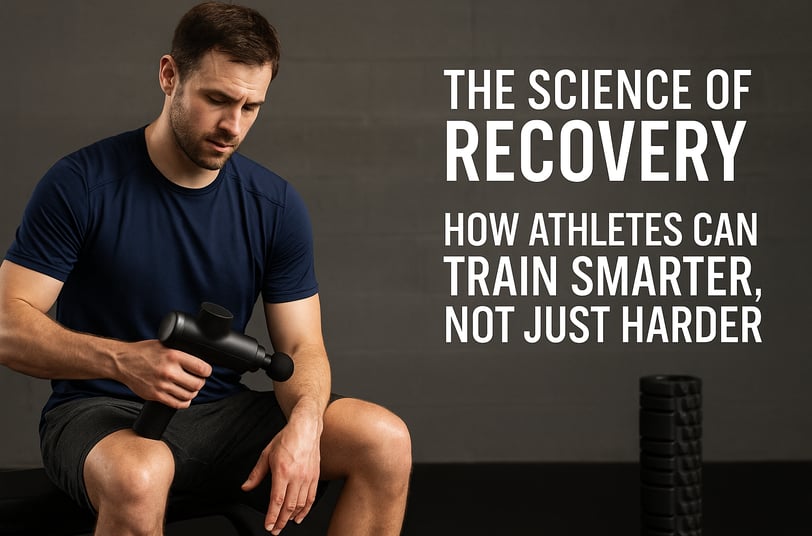The Science of Recovery: How Athletes Can Train Smarter and Improve Performance
Learn how smart recovery strategies—like sleep, nutrition, mobility, and self-massage—help athletes train harder, avoid injuries, and boost long-term performance. Discover practical tips and top recovery tools that actually make a difference.
5/20/20254 min read


The Science of Recovery: How Athletes Can Train Smarter, Not Just Harder
We all hear it—train hard, push yourself, go the extra mile. But if you're constantly grinding without giving your body the time to recover, you're not getting ahead. You’re just setting yourself up for burnout. The real secret behind high-level performance? It’s not just in the work—it's in the recovery.
Recovery isn’t something to “earn” after a tough workout. It’s part of the process. It’s what allows you to come back stronger, lift heavier, move better, and stay injury-free over time.
Why Recovery Deserves More Respect
When you train—whether you're lifting, running, or doing HIIT—you're breaking down muscle and ramping up stress hormones. That’s normal. But if you keep stacking intense sessions without proper recovery, your body doesn’t have time to repair. That’s when performance plateaus... or injuries creep in.
Even among elite athletes, overtraining syndrome is real—it’s been shown to affect up to 10% of them. And the solution isn’t always to pull back on training—it’s to get smarter about recovery.
5 Key Pillars of Smart Recovery :
Let’s break down the areas that really move the needle when it comes to feeling better, bouncing back faster, and staying consistent.
1. Sleep & Nutrition
Sleep is hands-down your best recovery tool. It’s when your body heals, your hormones reset, and your nervous system chills out. Without quality sleep, recovery gets cut short—no matter what else you’re doing.
And post-workout nutrition matters too. Getting enough protein, carbs, and fluids right after training helps refill glycogen, rebuild tissue, and rehydrate.
2. Active Recovery
Think light movement like walking, cycling, or a gentle swim. It keeps blood flowing, helps flush out waste, and supports recovery—without adding extra stress to the system.
3. Mobility & Myofascial Release
Mobility work and foam rolling can reduce tightness, improve movement, and even support better sleep and energy the next day. It’s not just for sore days—it’s maintenance.
🧰 Product we recommend: TriggerPoint Foam Roller Set
What it is: A compact set with a roller, massage stick, and trigger point balls
Why it’s great: Covers everything from big muscle groups to those small, sticky knots
When to use it: Perfect before workouts to prep the body, or after to reduce stiffness
Link to Amazon - https://amzn.to/4mr1SjO
4. Rest & Variation
You don’t need to “earn” a rest day. Strategically placing lower-intensity sessions or full days off helps your body adapt and rebuild. That’s how you actually grow stronger—not from pushing every single day.
5. Stress & Mind-Body Balance
Recovery isn’t just physical. When life stress, poor sleep, and mental overload build up, your body can’t heal as well. Mindfulness, breathwork, or even just time off social media can make a big difference.
Real Results: What Happens When You Recover Smarter
A study in the Journal of Sports Science showed that athletes who followed personalized recovery routines saw a 25% improvement in performance and had 30% fewer injuries. That’s huge—and it didn’t come from training more. It came from training better.
Recovery isn’t passive—it’s strategic. And smart athletes build it into their training just like their reps and sets.
🧰 Product we recommend : Hyperice Hypervolt 2 Pro
What it is: A top-tier massage gun with strong, quiet percussion
Why it’s helpful: Great for tight traps, quads, and glutes after heavy training or travel
When to use it: After hard workouts or on off days when muscles feel sluggish
Link to Amazon - https://amzn.to/4drdEqk
Don’t Just Go Hard—Recover Intentionally
Using tools like foam rollers and massage guns is helpful, but the real power comes from having a recovery routine. That might mean post-session mobility, daily walks, better sleep hygiene, or simply knowing when to back off.
Athletes are also turning to guided tools like the Whoop strap to measure strain and recovery—though even without tech, you can tune in to soreness, sleep, and mood as solid signals.
🧰 Product we recommend : Hyperice Normatec Elite Boots
What it is: A wireless compression system for legs
Why it works: Speeds circulation, reduces swelling, and feels amazing after long training blocks
Best time to use: After leg day, long runs, or while watching TV on a rest day
Link to Amazon - https://amzn.to/3FnOqwf
Weekly Recovery Plan (Made Simple)
Here’s a sample of how you might structure a smart training week that lets recovery keep up with the hustle:
Mon: Intense strength or sprint session
Recovery: Foam roll + Hypervolt + solid post-workout meal
Tue: Low-impact active recovery (light bike, mobility drills)
Optional: 30 min Normatec session
Wed: Moderate intensity workout
Thu: High-volume or skill-focused training
Fri: Lighter cardio + guided stretching or yoga
Sat: High-output session or competition practice
Sun: Full rest—sleep in, hydrate, decompress
The goal isn’t perfection. It’s progress—and that comes from knowing when to hit it hard, and when to step back.
Final Take: Why Recovery Wins in the Long Run
If you’re constantly sore, tired, or hitting performance plateaus, it’s not a sign to do more. It’s a sign to recover better.
The smartest athletes treat recovery as non-negotiable. With tools like the TriggerPoint Foam Roller Kit, Hypervolt 2 Pro, and Normatec Boots, you can level up your routine and stay ready for whatever your training throws at you.
Recovery doesn’t slow you down. It’s what keeps you in the game.
FITNESS
Nutrition
WellnesS
info@movebetterco.com
© 2025. All rights reserved | Privacy Policy | Terms & Conditions